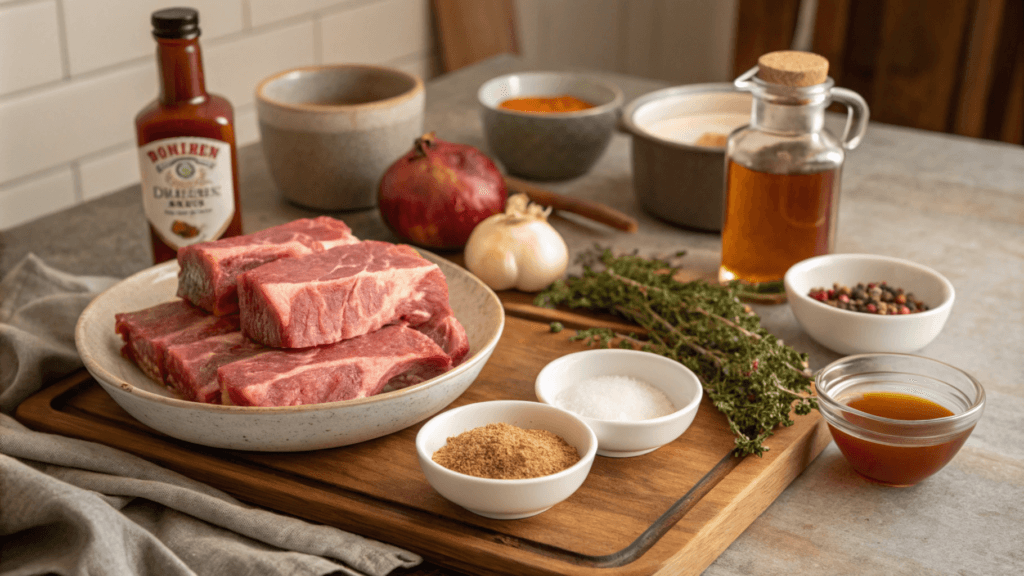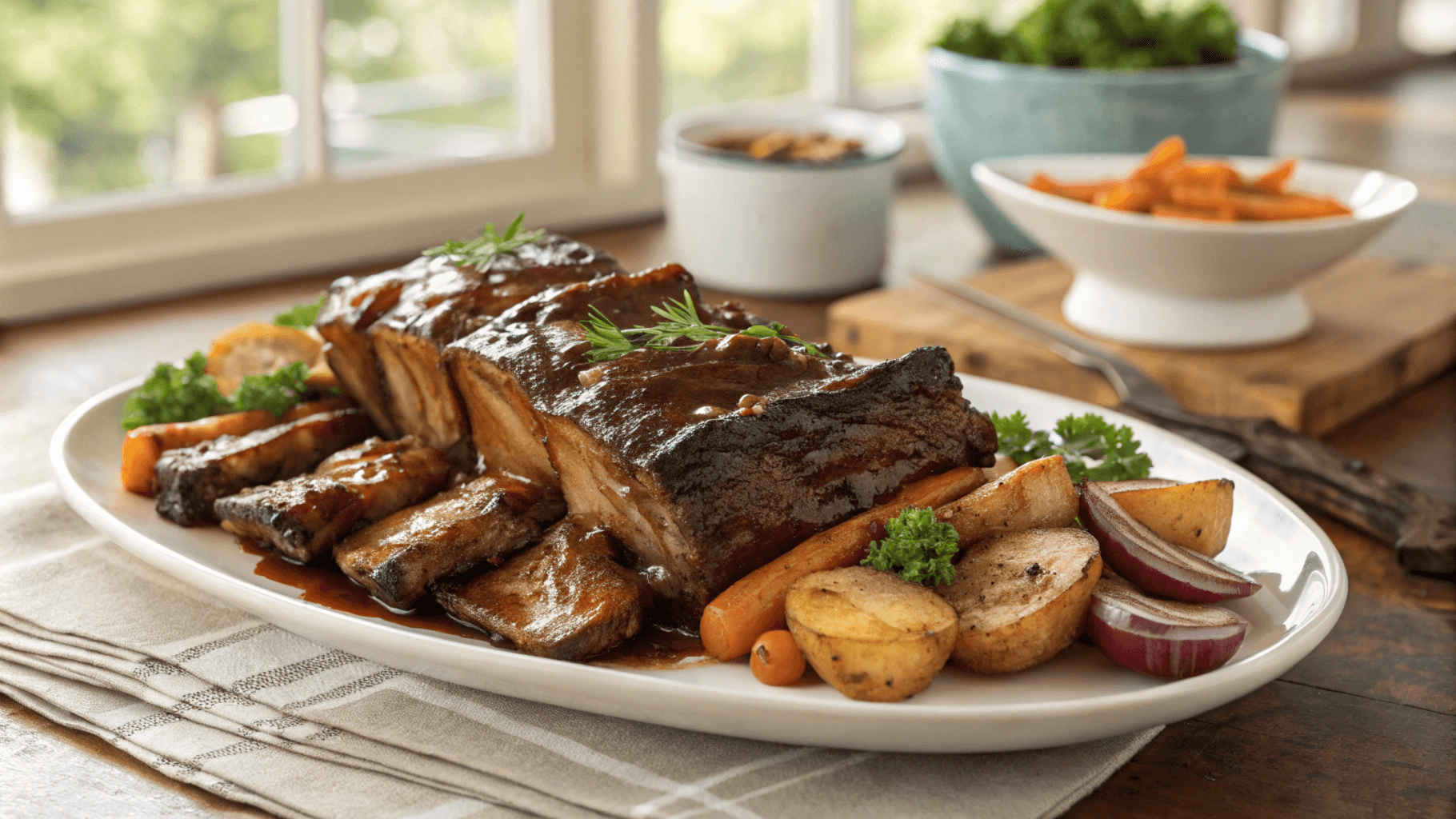Introduction: Why Slow Cooker Beef Ribs are a Game-Changer
Beef ribs are synonymous with rich, succulent flavor, but achieving that perfect tenderness can sometimes feel like a daunting task. Enter the slow cooker—a kitchen tool that effortlessly transforms tough cuts of meat into melt-in-your-mouth meals. Cooking beef ribs in a slow cooker is not only an incredibly convenient way to prepare a hearty meal but also a method that elevates the natural flavors of the meat to new heights. Slow cooking allows the beef to tenderize over an extended period, ensuring that every bite is infused with deep, savory flavor. For busy home cooks, this method is the ultimate solution, allowing you to set it and forget it while you tackle other tasks.
Essential Ingredients for Perfect Slow Cooker Beef Ribs
Choosing the Best Cut of Beef Ribs
Selecting the right cut of beef ribs is the foundation of a great dish. There are two main types: back ribs and short ribs. Back ribs are leaner, with a higher proportion of bone, while short ribs are meatier, offering a rich, beefy flavor. For slow cooking, short ribs are often the preferred choice due to their higher fat content, which breaks down during the long cooking process, resulting in more tender and flavorful meat. Always look for well-marbled ribs, as the fat will render and contribute to the tenderness and juiciness of the final product.
Must-Have Spices and Seasonings for Flavor
Seasoning your ribs properly is crucial for bringing out the meat’s natural richness. A basic rub typically includes salt, black pepper, garlic powder, onion powder, and paprika. These staples provide a balanced foundation of flavor. For more complex profiles, consider adding brown sugar, cayenne pepper, or mustard powder to your mix for a subtle kick of heat and sweetness. If you prefer a more regional touch, explore classic BBQ seasonings or international spices like cumin or smoked paprika to give your beef ribs an extra depth of flavor.
Optional Ingredients for Extra Tenderness and Taste
If you’re looking to push your slow-cooked beef ribs to new heights, certain ingredients can enhance both the texture and flavor. For extra tenderness, consider adding a splash of apple cider vinegar or a bit of worcestershire sauce to the cooking liquid. These ingredients help to break down the meat fibers and add a subtle tanginess that complements the rich beef flavor. Onions and garlic can also be added for an aromatic base that will permeate the meat, creating a savory and mouth-watering result.

Preparing Beef Ribs: Tips and Tricks for Maximum Flavor
How to Remove the Membrane for Tender Ribs
One of the most important steps in preparing beef ribs is removing the membrane, a thin, tough layer of tissue on the back of the ribs. Leaving this membrane on can result in chewy ribs that are difficult to eat. To remove it, use a butter knife to carefully lift one corner of the membrane and pull it away from the ribs. A clean paper towel can help grip the membrane and make the process easier. This small step is essential for ensuring your ribs have the best possible texture.
Marinating Beef Ribs: How Long and What For?
While marinating isn’t always necessary, it can significantly enhance the flavor of your beef ribs. For optimal results, marinate the ribs for at least 2-4 hours, but overnight is ideal if time permits. A marinade should include some form of acid (like vinegar or citrus) to help tenderize the meat, along with oils and herbs to infuse additional flavors. If you’re pressed for time, a dry rub can be just as effective and requires much less planning ahead.
Seasoning Techniques: Rubs vs. Sauces
When it comes to seasoning your ribs, there’s often a debate between using a dry rub or a sauce. Dry rubs, which consist of a blend of spices and herbs, are ideal for creating a flavorful crust on the meat that locks in moisture as it cooks. Sauces, on the other hand, offer a tangy, sweet, or spicy layer of flavor that can complement the natural taste of the ribs. The best method depends on personal preference, but many opt to combine both—rubbing the ribs with spices and then adding sauce towards the end of the cooking process for a glossy, flavorful finish.
Setting Up Your Slow Cooker for Success
The Ideal Temperature Setting for Beef Ribs
When cooking beef ribs in a slow cooker, it’s crucial to get the temperature just right. Set your slow cooker to low for a long, slow cook—usually around 6-8 hours. This will allow the collagen in the meat to break down slowly, resulting in tender, fall-off-the-bone ribs. If you’re short on time, you can cook the ribs on high for 3-4 hours, but this may not result in the same level of tenderness.
How to Layer the Ribs in the Slow Cooker
Properly layering the ribs in the slow cooker is important for even cooking. Arrange the ribs vertically or in a spiral pattern, ensuring that the meaty side is facing out. This allows the heat to circulate evenly and ensures that each rib gets the same amount of cooking time. If your slow cooker is small, don’t hesitate to cut the ribs into smaller sections to make them fit properly.
Importance of Liquid for the Perfect Slow-Cooked Ribs
Although beef ribs release their own juices during cooking, it’s essential to add a bit of liquid to the slow cooker to prevent them from drying out. A cup or two of beef broth, wine, or even apple cider will not only keep the meat moist but also create a flavorful cooking liquid that can be used as a base for sauces or gravies later. Make sure there’s enough liquid to cover the bottom of the slow cooker, but don’t submerge the ribs completely.
Cooking Time: How Long Does it Take to Cook Beef Ribs in a Slow Cooker?
Ideal Cooking Times for Tender Ribs (on Low vs. High)
Cooking beef ribs on low heat for 6-8 hours will result in the most tender, juicy ribs. This method allows the collagen in the meat to break down gradually, creating the desirable fall-off-the-bone texture. On the other hand, cooking on high for 3-4 hours can still yield delicious results, though the meat might not be as tender. If you’re unsure, always opt for the low setting to avoid overcooking.
Factors that Affect Cooking Time
Several factors can influence the cooking time of your beef ribs, including the size of the ribs, the cut of meat, and even the type of slow cooker. Larger ribs or thicker cuts will take longer to cook, while smaller or thinner ribs might be done sooner. The brand and model of slow cooker you use can also impact cooking times, as some cook more efficiently than others.
Testing for Doneness: How to Know When Your Ribs Are Ready
To test if your beef ribs are ready, use a fork to gently pull the meat away from the bone. If the meat comes away easily and has a soft, juicy texture, your ribs are done. Another way to check is by gently twisting the bone with your fingers; if it moves easily, that’s a clear indication that the ribs have reached optimal tenderness.
How to Achieve the Perfect Texture: Fall-Off-The-Bone Tenderness
The Science Behind Slow Cooking and Meat Breakdown
Slow cooking works wonders on tougher cuts of meat like beef ribs because the low, steady heat causes the collagen in the meat to break down over time. This collagen turns into gelatin, which helps to keep the meat moist and tender. As the meat cooks slowly, it becomes more flavorful, and the fibers loosen, making it easier to pull apart.
Key Signs Your Beef Ribs Are Done to Perfection
Perfectly cooked beef ribs should have a deep, rich color and a glossy, caramelized exterior. The meat should pull away from the bone with minimal effort, and the texture should be soft but not mushy. A gentle tug should reveal perfectly tender meat that has absorbed the flavor of the spices and cooking liquids.
Troubleshooting: What to Do if Your Ribs Aren’t Tender Enough
If your ribs aren’t as tender as you’d like, there are a few potential fixes. First, ensure you’re cooking them for long enough at the correct temperature. If they’re still tough, return them to the slow cooker and cook them for an additional hour or two on low. You can also add a bit more liquid to keep the ribs from drying out while they continue to cook.
Enhancing Flavor with Slow Cooker Beef Ribs Sauces and Glazes
How to Make a Simple Homemade BBQ Sauce for Ribs
A homemade BBQ sauce is an excellent way to finish off your slow-cooked beef ribs. A basic BBQ sauce typically combines ketchup, brown sugar, vinegar, and a variety of spices like smoked paprika and garlic powder. For extra depth, add a splash of worcestershire sauce or hot sauce for some heat. Simmer the ingredients over low heat until the sauce thickens, then apply it to the ribs during the last 30 minutes of cooking.
When to Apply Sauce for the Best Flavor
The key to applying sauce is timing. If you add the sauce too early, it may burn or become overly sticky. For the best flavor, brush the sauce onto the ribs in the last 30 minutes of cooking, allowing the glaze to caramelize and form a delicious coating on the ribs.
Alternative Flavoring Options: Marinades, Dry Rubs, and More
If you prefer to skip the sauce, marinades and dry rubs are great alternatives for enhancing flavor. A wet marinade can be used for a tangy, aromatic finish, while a dry rub creates a flavorful crust that intensifies during the slow cooking process. Experiment with different spice blends and flavor profiles to find the combination that suits your tastes.
Adding Extra Ingredients for a Complete Meal
Veggies and Potatoes: Perfect Sidekicks for Slow-Cooked Beef Ribs
Slow cooker beef ribs pair wonderfully with vegetables and potatoes, making it easy to create a complete meal in one pot. Add carrots, onions, potatoes, or sweet potatoes to the slow cooker during the last 2-3 hours of cooking. These ingredients will absorb the rich beef flavors and become tender alongside the ribs.
How to Cook Vegetables in the Same Slow Cooker
When cooking vegetables in the same slow cooker, make sure they are cut into uniform sizes for even cooking. Root vegetables like potatoes, carrots, and parsnips are ideal as they hold up well to long cooking times. Place these vegetables at the bottom of the cooker, under the ribs, as they will need the most time to cook.
Complementary Dishes to Serve with Beef Ribs
For a well-rounded meal, pair your beef ribs with simple sides like coleslaw, cornbread, or a fresh green salad. A tangy, refreshing side will balance the richness of the ribs, while the slight crunch of a salad contrasts beautifully with the tender meat.
Slow Cooker Beef Ribs vs. Oven-Baked: Which is Better?
Comparing Cooking Times and Results
While oven-baked ribs are often quick and convenient, the slow cooker provides a far more forgiving environment for beef ribs. Slow cooking allows for a slower breakdown of collagen, which results in more tender meat. Oven-baked ribs, though delicious, can be tricky to time, and there’s a greater risk of overcooking.
Pros and Cons of Each Method
The slow cooker’s primary advantage lies in convenience—it requires minimal attention and produces reliably tender ribs. The oven method offers a slightly faster cooking time but demands more precise monitoring and may not yield the same fall-off-the-bone tenderness.
Cost and Energy Considerations: Slow Cooker vs. Oven
While an oven consumes more energy over long cooking times, a slow cooker uses less power, making it more cost-effective in the long run. Additionally, slow cookers tend to be more compact and require less preheating, contributing to energy savings.
Troubleshooting Common Slow Cooker Beef Ribs Mistakes
Overcooked or Dry Ribs: How to Avoid It
To avoid overcooked or dry ribs, always cook on low heat and be mindful of the cooking time. Keep an eye on the ribs during the final hour to ensure they don’t become too dry or tough. You can also add more liquid during cooking to help maintain moisture.
Under-Seasoned Beef Ribs: How to Correct the Flavor
If your beef ribs turn out under-seasoned, a quick fix is to sprinkle a bit more seasoning or dry rub over the ribs and let them sit for 10-15 minutes. You can also drizzle a small amount of BBQ sauce over the ribs for added flavor and moisture.
Ribs Too Tough: Why It Happens and How to Fix It
If your ribs are too tough, it’s likely that they need more cooking time. Return them to the slow cooker and cook on low for an additional hour, checking for tenderness. If the ribs were cut too thick, try cutting them into smaller pieces next time to ensure even cooking.
Storing and Reheating Leftover Slow Cooker Beef Ribs
Best Practices for Storing Leftovers
Leftover beef ribs should be stored in an airtight container in the refrigerator. For optimal freshness, consume them within 3-4 days. To prevent the meat from drying out, store the ribs with some of the cooking juices or broth.
How to Reheat Beef Ribs Without Losing Flavor and Texture
Reheat your ribs in the oven at a low temperature (around 150-170°F) or gently on the stovetop in a covered pan. For extra moisture, drizzle some of the leftover cooking liquid or BBQ sauce over the ribs before reheating.
Creative Ways to Use Leftover Beef Ribs in Other Dishes
Leftover beef ribs can be repurposed in many ways, such as in tacos, sandwiches, or stir-fries. Shred the meat and mix it with some fresh ingredients, and you’ve got a brand-new dish that’s just as flavorful as the original.
Conclusion: Enjoying the Perfect Slow Cooker Beef Ribs
Cooking beef ribs in a slow cooker is an easy way to achieve mouth-watering, tender meat every time. By following the right steps—from choosing the best cuts to seasoning and cooking at the perfect temperature—you’ll be able to create a meal that’s both convenient and delicious. With endless possibilities for flavor combinations and sides, slow-cooked beef ribs should be a staple in any busy home cook’s meal plan. Don’t be afraid to experiment with new spices, sauces, and marinades to make these ribs your own.

